How to choose the best plants for dry shade
It can be difficult to choose plants for dry shade.
I have a small triangular area between two paths, where I had hoped to grow rhubarb. It took me years to realise that it was under a clump of small trees and that rhubarb likes sunshine. And rain. This rhubarb was never going to clump out into a lush border. It would always look straggly.
In my eagerness to enjoy a spread of beautiful big leaves, I’d forgotten the ‘right plant, right place’ principle.
If you have a tall wall and/or a group of trees in your garden, you’ll have dry shade.
And if your wall or trees are north-facing, you have a very shady area. Don’t even try to experiment with anything other than shade-loving, drought-tolerant plants. You’ll know you’ve got the wrong plants if they get leggy, straggly or fail to clump out into nice groups.
If the wall or trees face south, west or east, then you’ll get some sunshine at certain times of the day or year. So you can be a little more flexible or experimental. There’s more about different kinds of shade here.
And the base of your wall will either be drier or wetter than the rest of your garden, depending on the prevailing wind. The wind may drive rain into your wall or fence, so it runs down to the base. Or the wind will drive rain over the top, creating a mini desert at the base.
My top 10 plants for dry shade
- Astrantia – it’s worth a try
- Aucuba japonica – unfashionable but reliable
- Bergenia – indestructible and pollinators love it
- Hardy cyclamen – not the florist’s indoor plant variety
- Euphorbia robbiae – but it can spread!
- Fatsia japonica – a hardy, easy going plant for a jungle look
- Ferns – Just get varieties right(dryopteris or polystichum)
- Foxgloves – spires of colour in shady places
- Hardy geraniums (varieties: macrorrhizum and phaeum)
- Ivy – make sure you cut it back at least once a year
Firstly, decide what style or effect you want
What do you want your plants for dry shade to achieve? If you have a distinct garden style, such as English country, cottage garden or wildlife-friendly, then that will help narrow down your choices.
I would define my style as roughly English country, although it’s a town garden. And I focus on wildlife-friendly planting. So I think that I should take ‘woodland garden’ as my inspiration for this small triangle.
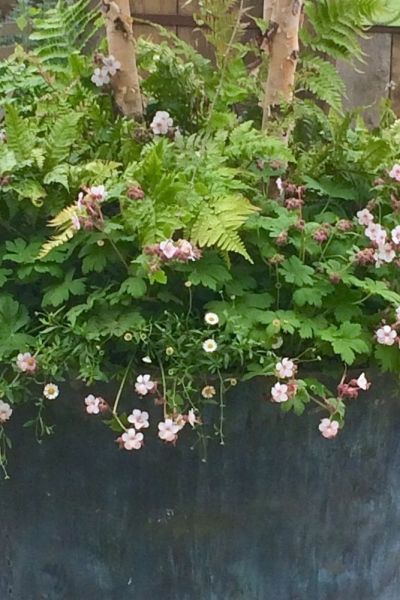
A beautiful shade combination from designer Richard Taylor of Taylor Tripp Garden Design. It’s a ‘mini woodland pot’ for an RHS Chelsea Flower Show and is Geranium macrorrhizum ‘Spessart’, together with Erigeron karvinskianus and Dryopteris erythrosora. The tree was River Birch, Betula nigra. It’s so pretty – I shall take this as my inspiration.
Another good look for a small area of dry shade could be jungle-style, with layers of big leafed plants.
Look at your dry, shady spot from all angles
Do you see the dry, shady area from the house? Or if you’re sitting in the garden, what do you see or want to see in that area? This will help you decide if you want deciduous plants for dry shade, so that your plants lose their leaves in winter. It will also help you decide whether you want taller plants or ground cover.
I can see this little triangle of garden from several windows in the house. It looks very pretty in spring, when the bulbs are out. So I’ve decided that I don’t want to cover the whole area with evergreens. I also want quite low plants to contrast with the trees and to see the shape of the path.
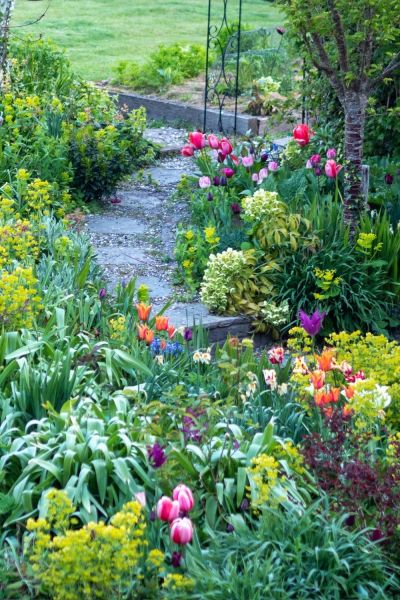
The dry shady triangle I want to plant up is on the right of this path. I like to see the path, so I don’t want to plant big evergreens here. I’d like to focus on plants that will let the bulbs shine in spring.
But if you want to screen something beyond your dry, shady area, you’ll want evergreens and taller plants.
Know what sort of a gardener you are
Do you want a low maintenance garden? Or would you like to focus your gardening efforts elsewhere and just have something pleasantly green covering that dry shady spot?
I once saw a shady brick pathway lined with ferns at Sandhill Farm House, the garden of Rosemary Alexander of the English Gardening School. It was so smart and stylish. Perhaps I could go for a block of ferns, neatly planted in a chunk? It would be contemporary and easy care.
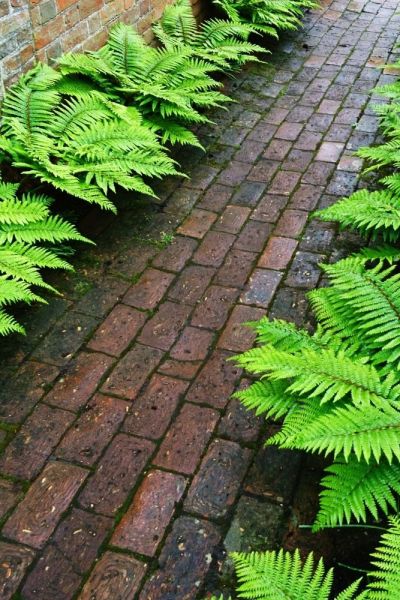
A shady brick path at Rosemary Alexander’s Sandhill Farm House. This is such a simple, stylish treatment. Perhaps a grouping of ferns is all you need in a shady, dry area.
But I am not a neat gardener. Plants self-seed here. And I love that unexpected side of gardening. A smart, stylish effect like this needs to be kept smart and neat. That doesn’t necessarily mean a lot of work. But it does mean editing out any other plants or weeds as soon as you see them.
You are either someone who will do that or you are not. I am not. Therefore this is not the effect for me. But you might be. And it could work with bergenia as well as ferns.
Generally, shady borders and areas are easy to look after as weeds and plants don’t grow so fast. See more about why shady borders can be the best part of your garden here.
Look at what’s there already (or see a neighbour’s garden)
Look at any dark shady corners you have. What’s doing well? I’ve got a harts tongue fern colonising the corner of a wall, so it should do well.
Garden designer Posy Gentles gave me a clump of astrantias when she was dividing them. They’re next to a north facing wall and doing well. So although ‘astrantia’ isn’t in all the lists of plants for dry shade, it may be worth trying where you are.
And when I look through photos or friends’ gardens, I sometimes see plants in dry shade – and they’re doing well, even if they technically shouldn’t be. So it’s worth experimenting a bit.
Cross-check several websites and plant labels
I looked at quite a few websites while searching for the best plants for dry shade. They varied hugely in their recommendations. And some contradicted others.
For example, I have seen hydrangeas and hostas recommended for dry shade. But both those plants do need a certain amount of water. The most drought-resilient hydrangea is the oakleaf hydrangea. And I have seen Hydrangea arborescens ‘Annabelle’ do well in lighter dry shade, although you will have to water it occasionally in very dry spells.
Plant labelling can be too general to be much help. If you like the look of a plant, check the label, but it’s also worth checking it out on a couple of websites as well. Look for the words ‘well drained soil’ or ‘drought tolerant.’
And if the information is too contradictory, then maybe it’s worth taking a risk. Experiment. The plant may work in your dry, shady spot or it may not. But if you’re prepared to put up with a few failures, you should also have a few unexpected successes.
As I always say, ‘gardeners learn by trowel and error.’ I even have the T shirt (for sale!).
Astrantia – delicately pretty and worth a try
Astrantias are often described as loving moist soils. But they’re also recommended as good for planting under trees. There is never any moist soil under trees round here.
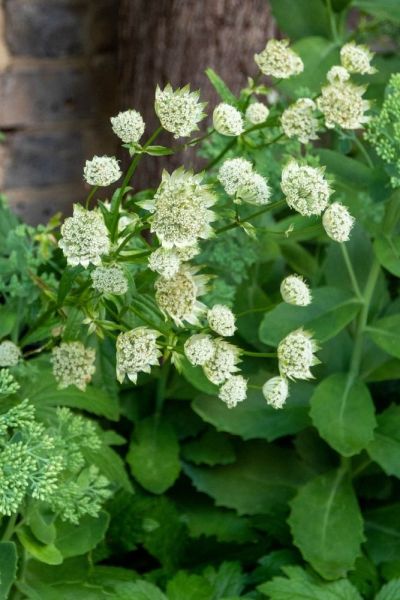
This is Astrantia ‘Billion of Stars’. It looks very pretty and seems to cope with dry shade well.
And, as I said, we are one of the driest areas of the UK, with around 26″/66cm annual rainfall a year. Astrantias seem to do well, both in my garden and in friends’ gardens.
For all its prettiness, astrantia is very hardy too. It’ll survive winters anywhere in the UK and Zones 4-9 in the US, although it may not like the hottest summers.
Aucuba japonica – tall, evergreen and brightens up a dark spot
This is possibly the least fashionable plant in today’s gardening. It’s considered municipal and boring. But its yellow-spotted leaves brighten a dark spot and it looks after itself. It just needs occasional pruning – I don’t even prune mine every year. And it’s evergreen. It gets quite large – mine is around 10ft/3m tall.
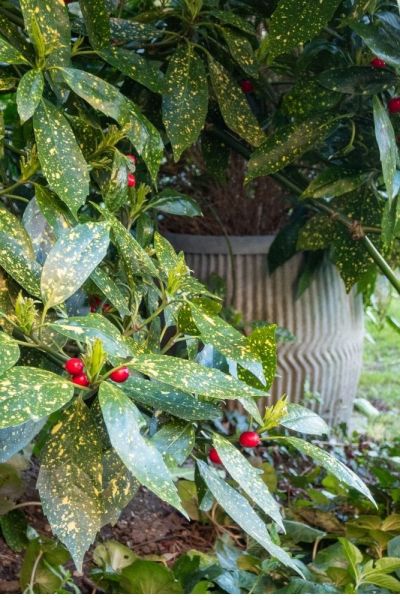
Aucuba japonica. So very unpopular but look at those yellow splashes against the red berries. Time for a re-think? Good if you need evergreen screening in your dry shade.
For such a thuggish looking plant, it’s a little tender, but it survives any UK winter, however harsh. And it’s 7-9 for the US zones.
Bergenia – indestructible and pollinator-friendly
Most large-leafed plants require a certain amount of water, but bergenia seems to cope with anything. If my post on 5 resilient flowers that bloom all summer had covered spring too, bergenia would definitely have been top of the list.
Its pink, red or white flowers are the first to come out in spring, providing early food for pollinators.
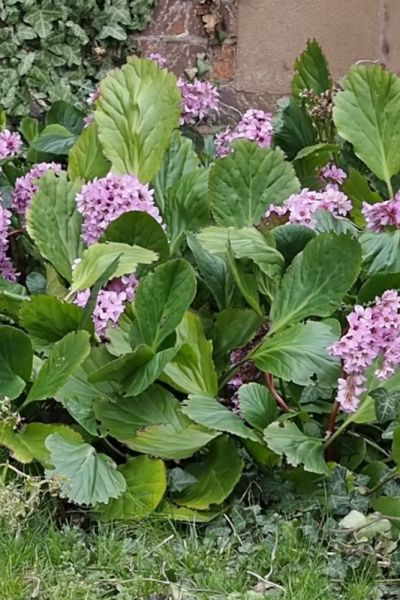
Bergenia – these flowers come out in late winter and go on throughout the spring. The plant is tucked into a corner between two walls.
When you look up ‘bergenia’, many websites say it needs ‘moist, well-drained soil.’ However I have one clump beside a wall under a tree, and another in a shady spot between two walls. Neither have ever been watered. Bergenia is evergreen, too and survives UK winters and USDA zones 4-8. Apparently some of the foliage may die back in really cold, snowy winters, but it reliably returns.
Cyclamen – autumn flowering and ivy leafed
This pretty little pink or white plant flowers in autumn and has pretty ivy-shaped leaves in spring. It seems very happy in the shade of trees and just spreads. Plant some. If it likes your garden, it will slowly spread. If it vanishes, you’ll know it was in the wrong place.
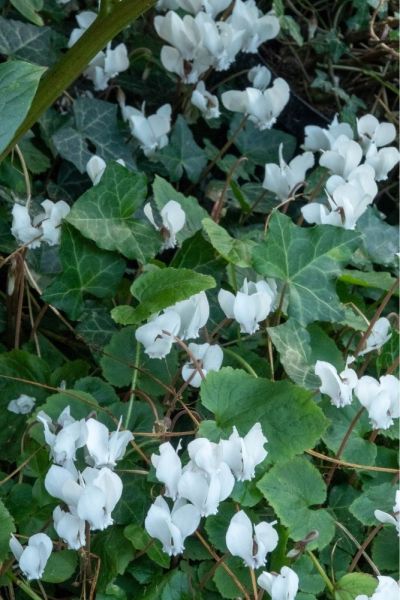
Cyclamen and ivy – two of the easiest plants for dry shade
Hardy cyclamen can cope with winter temperatures down to minus 20F, minus 28 Celsius, so that’s fine for UK winters and USDA zones 5-9.
Don’t confuse it with florist’s cyclamen. That frequently doesn’t survive the winter when planted outside.
Euphorbia robbiae – but it can be invasive in some places
To give it its full name, Euphorbia amygloides subsp ‘Robbiae’ is a plant that will grow easily in any dry, shady spot. Your main job will be to pull it out when it spreads too much. But its spread does make a lovely weed-smothering carpet.
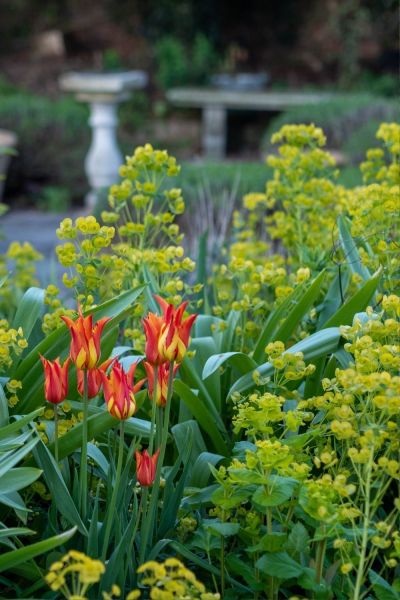
Euphorbia ‘Robbiae’ spreads but is a welcome foil for spring bulbs and early summer flowers.
Euphorbia robbiae also flowers for a long time, from early spring to early summer. It has light citrus green flowers. And an RHS Award of Garden Merit.
I have to pull out clumps of ‘Robbiae’ regularly in this garden. But I still enjoy having it. It’ll survive winters down to minus 23C or minus 10F, so that’s all UK winters plus USDA zones 6-8.
Fatsia japonica – exotic-looking but very resilient
Another good option for a dry shady area is ‘jungle planting’ because it’s good for small areas of shade. I don’t think that style would suit my garden, although it’s very tempting.
If you fancy a layered jungle look, see Emma Mason’s show border in this post on BBC Gardeners World Live for an example. Fatsia is one of the plants she used.
Fatsia japonica is another plant that used to be very popular and then fell out of favour. But it’s back now, especially the variegated varieties. It has such a good leaf shape and seems to put up with almost endless neglect. It can get quite big but is easy to prune.
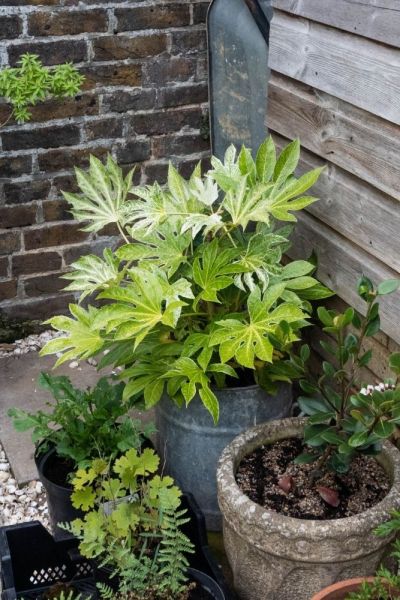
A variegated fatsia japonica in garden designer Posy Gentles’ garden. It does well in a pot and if you have colder winters – below minus 10C – then take inside and treat as a houseplant. But it’s hardy in UK winters and very resilient.
This is hardy in UK winters. But it doesn’t like to go below about minus 10F/minus 20C (USDA zones 7/8-10), so it’s not reliably hardy in much colder climates.
Ferns – check the variety
I’ve often had trouble getting ferns established. I’ve now discovered, while doing the research for this post, that this is probably because you need to water them well in the first season after planting. After that, the drought-tolerant ferns will look after themselves.
When I looked up Harts-tongue fern online, I discovered that it apparently requires ‘moist, shady spaces’. Well, it is currently growing out of my garden wall, in a corner. I thought there was nothing moist about my garden wall, as we have one of the lowest levels of rainfall in the UK. However, looking at the wall I can see a patch of damp, which must be addressed. So it’s worth remembering that your plants can tell you important things!
Otherwise Polystichum (mainly evergreen) and Dryopteris (mainly deciduous) ferns are considered to be drought tolerant once they’ve settled in.
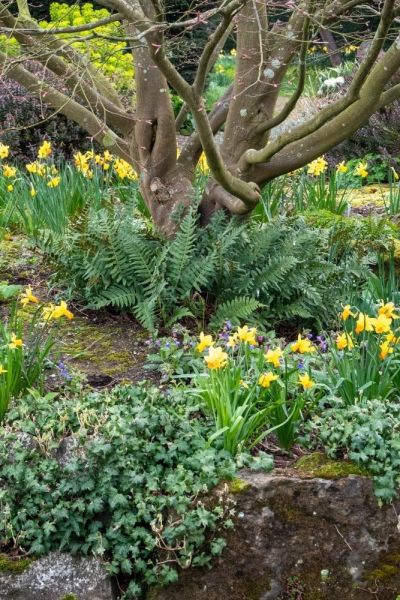
Ferns planted at the base of a tree in Doddington Place Gardens. In summer, the tree canopy will create almost total shade but in winter, leaves are off the trees and there is enough light for the bulbs to grow. You can also see ground cover ivy in the foreground.
There are so many ferns. You should be able to find one from a supplier near you which matches your winter conditions and soil.
Foxgloves – tall spires of colour in late spring
I’ve had a few failures growing foxgloves in dry, shady parts of the garden. But if I let the foxgloves self-seed, then they pop up in the most difficult places. I’ve seen a wonderful display of foxgloves growing round the base of a tree at Doddington Place Gardens.
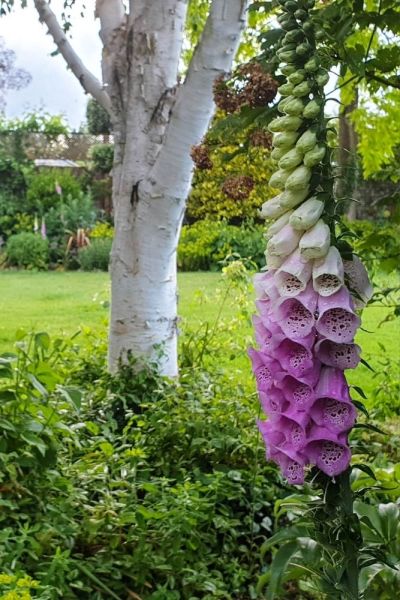
This fern self-seeded itself in the very spot that I am currently re-planting. It’s a biennial fern, so once it’s flowered it dies, but scatters its seeds around. I hope they’ll regrow.
Foxgloves are hardy in winters down to around minus 30F/minus 24C, so USDA zones 4-8. And they’re happy in UK summers, although the UK is often considered equivalent to a Zone 9.
Hardy geraniums (macrorrhizum and phaeum)
Hardy geraniums are such pretty, modest plants. They clump out and give months of flowers. I’ve always admired Posy Gentles’ shady planting combination of Geranium macrorrhizum ‘Spessart’ and Saxifrage ‘London Pride.’
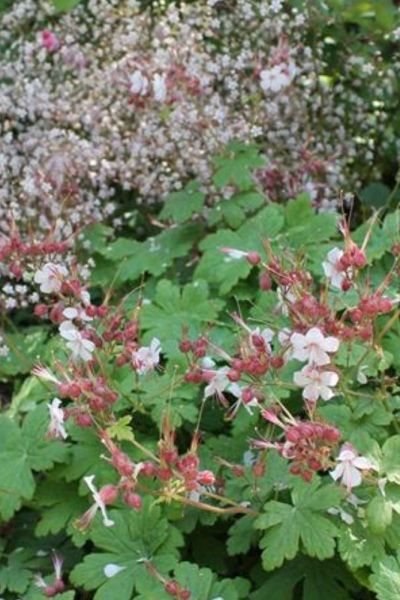
Hardy geranium macrorrhizum ‘Spessart’ with a froth of Saxifrage ‘London Pride’ in the background.
And Posy chose a deep pink Geranium macrorrhizum for a shady position by a wall in this post 10 low maintenance plants for a long-lasting garden.
And hardy geraniums are very hardy, with many of them happy in winters of minus 20F/minus 29C, so USDA zones 5-9 and anywhere in the UK.
Ivy – wildlife-friendly and low maintenance (but beware)
We often consider ivy a weed. It can get out of control. It is considered invasive, and therefore damaging in some countries. Check whether this is the case where you live.
But, in the UK, if you’re prepared to cut it back ruthlessly once a year, it offers evergreen cover plus flowers and berries for wildlife. And you can get pretty variegated varieties. It’s good either as ground cover or as a climber.
Ivy is another very hardy plant, surviving winters down to minus 30F/minus 34C, so USDA zones 4-9 and anywhere in the UK.
Pins to remember plants for dry shade
And see here to get a free weekly email from the Middlesized Garden, with more tips, ideas and inspiration for your garden.

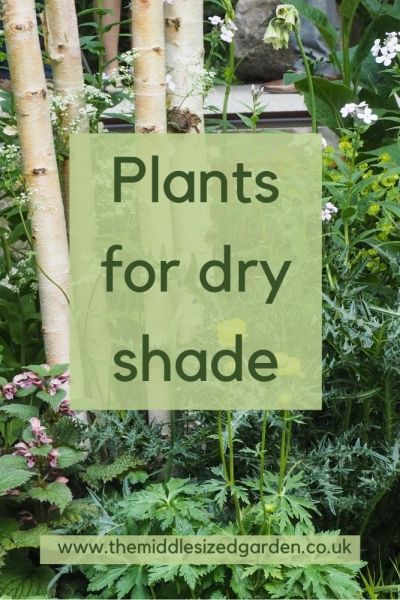























Perhaps very late to the party, but thought you might like to know, indeed it is Geranium macrorrhizum ‘Spessart’, together with Erigeron karvinskianus and Dryopteris erythrosora. The tree was River Birch, Betula nigra. I know because I designed this scheme for a Chelsea Flowershow exhibit we did a few years back! Glad you like, I really do think it’s very effective too.
Thank you for getting in touch, it is really a beautiful combination and I will amend the caption to include the extra details
I rarely comment, but I wanted to say your blog and videos are the absolute highlight of my weekends. I look for your posts in my in-box first thing before opening other emails. Thank you!
Thank you so much – that’s lovely to hear!